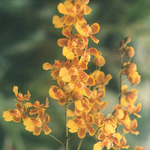
 |
 |
|
Most Common Orchids
Other Links
|
| Home | | | Anguloa | | | Cattleya | | | Cymbidium | | | Oncidium | | | Epidendrum | | | Catasetum | | | Miltonia | | |
|
Oncidium
Oncidiums are popular indoor plant. It grows well in indoor condition. It consists of large pseudobulbs that arise from mass of thin white roots. It has large leaves (up to 2 ft.) emerge from the pseudobulbs. It flowers in fall.
Fertilizer : While using fertilizer, use green jungle every time, all year around with rain, distilled, reverse osmosis water. Whereas for tap or well water we can fertilize with grow more urea free 20-10=20 at the rate of half teaspoon per gallon.
Light : The plant must be grown in diffused light. Besides sunlight high-pressure sodium or metal halide fixtures can be use as artificial light for the orchid.
Water : We must water the plant when the mix just approaches dryness. Oncidium prefer clean water without a lot of minerals content. For best grow we must use distilled reverse osmosis or rainwater. We cannot use softened water.
Humidity : The ideal humidity level for these plants should be kept at 40% or above.
Temperature : Oncidium plant prefers night temperature up to 60˚ - 64˚ Fahrenheit during fall, winter and spring months. And ideal daytime temperature is up to 70˚ - 85˚F.
Flowering : More flowering generally take place during fall and spring. Many hybrids can bloom 2-3 times per year. The flower spiker on Oncidium generally grows to a medium or tall length and branch out in several directions.
Repotting : Repotting can be done every 1 to 2 years as the mix break down or as plant outgrows the pot. Plant that is potted in a bark mixture must be pulled out carefully. We must simply place the plant into new pot placing oldest growth towards back of the pot. Usually Oncidium is planted either in orchid bark mix or New Zealand sphagnum moss mixed with tree fern fiber.
